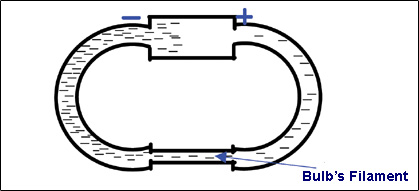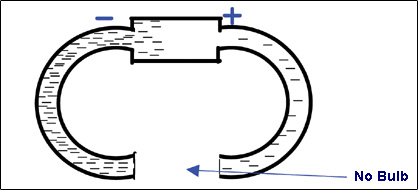Simple Circuits Curriculum
Section 8: Lesson Plan
Materials
- White board or overhead of the diagram, Illustration of Electrical Potential with an Underlying Relational Causal Model (PDF 86 KB)
- Thinking About Relational Causality sheet, 1 per student (PDF 101 KB)
Prep Step
- Review the lesson plan, background information, and understanding goals.
- Prepare white board or overhead of the diagram, Illustration of Electrical Potential with an Underlying Relational Causal Model.
- Photocopy the sheet, Thinking About Relational Causality sheet, 1 per student.
Analyze Thinking
Step 1: Reviewing Concepts from Static Electricity
Remind the students about the ideas of imbalance and net charge from static electricity. Can anyone explain it? Ask them to draw a model that illustrates the concept.
When there are equal numbers of electrons and protons in a part of a material, they are balanced and there is no net electrical charge. When there is an excess of electrons or an excess of protons, there is net electrical charge. Because electrons are repelled by other electrons and attracted to protons (and protons are repelled by other protons and attracted to electrons) they "seek out" balance, i.e. electrons without proton pairs will move away from other electrons and towards protons. This is what happens when you get charged, or "shocked" from, for example, shuffling your feet on the rug. You have an excess of electrons, and you feel a shock when they repel each other and seek out protons by repelling their electron partners and attracting to the protons. Imbalance = charge, and net charge refers to the net difference between the number of electrons and the number of protons when there are more of one than the other.
RECAST Thinking
Step 2: Introducing the Concept of Electrical Potential
Explain to the students that you are going to show them another way of explaining a simple circuit. It is similar to the Cyclic Simultaneous Model in some ways, and different in other ways. Both are "scientifically accepted" ways of explaining how a simple circuit works. It uses the concept of "electrical potential." It is less zoomed in than the Cyclic Simultaneous Model. You still look at what the electrons are doing, but don't worry about the behavior of individual electrons as much as how they behave as a group.
The model based on electrical potential uses the idea of net excess charge, which the students should have learned when studying static electricity. Draw the following diagram on the board or use the PDF version to project with an overhead projector. The narrowest part of the diagram represents the bulb's filament (the part of the bulb that carries electron flow and acts as a resistor). The widest part at the top represents the battery (the repository of electrons), and the wide bands connecting the battery and the bulb(s) represent the wire. The minus signs throughout the circuit represent electrons. Explain to the students what each part of each circuit represents.

Illustration of Electrical Potential with an Underlying Relational Causal Model
Tell your students that before they hook up the wires, the wires are balanced. There are electrons and protons all along the wire, as discussed in the Cyclic Simultaneous Model, but they are not charged. There is a charge in the battery because the chemical in the battery does work to separate protons and electrons. This results in an excess of protons at the positive contact and an excess of electrons at the negative contact. In order to illustrate this, draw all of the negatives at the negative terminal of the battery. If you hook the wires up to the battery but don't put the bulb in yet, it would look like this. Notice the higher density of electrons on one side and the lower density of electrons on the other.

Illustration of Electrical Potential with an Underlying Relational Causal Model
Now ask the students to think about where that excess charge is going to go. It is going to move through the circuit to the positive terminal. If they know about air pressure, remind them that things move from areas of greater concentration to areas of lesser concentration. There is a very small transient delay (not noticeable at all) as the circuit gets up to the point where excess electrons flow along the wire. This point is called "steady state."
Explain that the "work" that the battery does results in an excess of protons on one end of the battery and an excess of electrons on the other. This is work because the protons and electrons are attracted to each other and creating excesses of electrons (which repel each other) and protons (which repel each other) requires energy, which is provided by the chemicals in the battery. The accumulation of electrons at the negative contact, and the depletion of electrons at the positive contact as well as the abundance of protons, creates a differential so that the electrons flow away from areas of higher concentration and towards areas of lower concentration of electrons.
So what is voltage? Explain that the battery is performing work. The electrons are attracted to the protons. The more electrons that concentrate on the negative terminal, the harder it is for the battery to push more of them over there. The net negative electrical charge is increased at the negative terminal, and the net positive charge is increased at the positive terminal. The higher the voltage of the battery, the greater the chemical potential it has to separate protons and electrons. The chemical has the ability to concentrate electrons on the negative contact, resulting in a differential between the negative contact and other parts of the circuit that results in flow. Volts are the unit by which voltage is measured.
RECAST Thinking
Step 3: The Concept of Electrical Potential and Relational Causality
The concept of electrical potential and models based upon it have an underlying causality that is relational. Have the students read the sheet, Thinking About Relational Causality, and discuss it together. Have they seen this type of causality in any other science topics that they have studied? It is the underlying causality in air pressure and density differentials, for example.
Step 4: Comparing Models Based on Electrical Potential (with Relational Causality) to those with Cyclic Simultaneous Causality
Discuss how models based on electrical potential that use relational causality are similar to the Cyclic Simultaneous Model and how they are different. In both types, you have to analyze what is going on by looking at the whole system. The Cyclic Simultaneous Model involves thinking about particles as though they are a bicycle chain. The Electrical Potential/Relational Causal Model involves thinking about particles as a continual wave of oscillating movement as electrons repel each other along the circuit.
However, the gradient in amount of "crowdedness" of electrons exists only when the current is flowing through the system.
Discuss how the Electrical Potential/Relational Causal Model is similar to the Cyclic Sequential Model. Tell the students that one reason for not showing them the concept of electrical potential first is that it has some similarities to the Cyclic Sequential Model, and could lead them to revert back to that earlier model, which has lots of problems from a scientific point of view. It is similar in that the Cyclic Sequential Model involves something moving along the wires. However, it is usually thought of as a substance, electricity as stuff, rather than a process of electrons repelling other electrons. Because of this, the Cyclic Sequential Model encourages the erroneous view that the current (seen as "stuff") is used up and that there is less of it available to components further from the battery. It diverts attention from a systemic view of the circuit.
Ask students to raise questions. What is clear? What is still unclear? Discuss answers to their questions. You may need to review ideas about balance and imbalance in static electricity. Raise the question, "If the process is like static electricity, why doesn't it just stop after one surge like static electricity does? What makes it continue to flow?" The battery maintains a differential.
Review, Extend, Apply
Step 5: Assessing Understanding
Ask students to explain the concept of electrical potential and the underlying Relational Causal Model in their own words and then critique it. They should draw a model and write a paragraph or two explaining it. They should include two to three things that they think work well about their model as an explanation; and two to three things that they think don't work well. They should also list any questions that they have about it.


